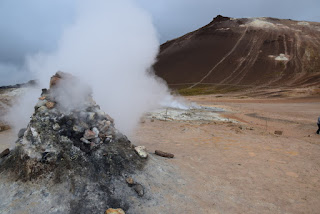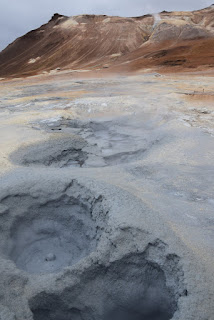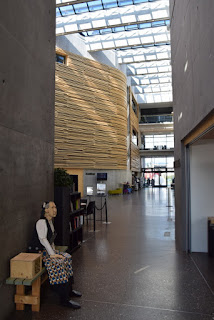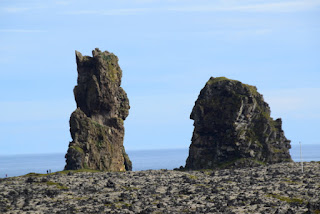As we moved around the East to
the North coast the landscape changed to huge glacier valleys and fiords. Even
so there were waterfalls. The Dettifoss fall is the most powerful in Europe
with some 500 m³ going over every second. However, I think the
one a kilometre upstream called Selfoss was more captivating due to its length.
The river appears to have
almost hewn its way through lava blocks to develop a wonderful gorge some of
which had a pipe effect reminiscent (but not as well defined) of the Devils
Causeway in Ireland (see August 2010 blog)
We had an overnight stop on
Lake Myvatn. Our hotel overlooked a number of craters formed by steam when the hot
lava hit and trapped the water. Notwithstanding the volcano eruption these must
have been quite a side show in their own right. The underlying geology still
keeps the lake a little warmer than other melt water and this is very attractive
to a huge range of birds including hundreds of swans.
As we approached the midway point
of the North coast the geothermal activity once more increased where the plates
that “divide” Iceland cut through from the South. Some of the features were
pretty hard to comprehend how they were formed. The theory here is that as with
the previous photo lava trapped water. In this case as the subsurface heated
the lava it was pushed up through the crust and a steam pipe was formed. Well
it is only a theory…..
Just around the corner was
the Krafla geothermal power plant. Straight out of Star Wars. These are the housing
to bores about 2 kms deep (with some also having additional horizontal bores)
which allow steam and water to be captured for use in driving turbines and
supplying hot water to the local community.
Namafjall Hverri is one of the largest areas of
geothermal activity sitting as it does right over the Mid Atlantic ridge. Apart
from the sulphorous smell the noise from these pressure vents was quite
intimidating. Rather like standing next to a giant pressure cooker valve - is
it going to blow? The contrast between the heat of the steam and ambient
weather conditions (about 6°C less wind chill factor) was stark.
Signs suggest visitors walk
on the marked pathways as you never know what could turn out to be a hot spot –
although some were quite obvious.
The last of the major
waterfalls for us was Godafoss. This was actually the first stop where we had to get
out and walk in the rain! The main fall is in the background but this shot
gives an appreciation of the whole gorge.
We then had a two night
stopover in Akureyri where there are many sights. See if you can pick the
Trolls…..
There were many wooden
figures dotted around the place including one in the Hof (Concert Hall)
which with its glass roof really illuminated the carefully shaped timber
feature wall.
We were now entering Saga and
Nordic crime fiction country and a leisurely day round town was cut short for a
100 kms trip up to Siglufiorour which was the setting of one of many novels read by Helen. Here there was a large and fascinating herring museum. There
was so much to see but this ’40 something till with its lovely curved timber
lines rather overwhelmed today's small credit
card reader to the right.
The boats that were used for
fishing would have been pretty uncomfortable (not to mention dangerous on any
sort of sea). The fishing, salting and exporting of herring was a massive industry
and the conditions of work and accommodation certainly would not do today’s
workers. Some of the pictures (banks of barrels stacked 15 or more high – wouldn’t
it be fun to pull out the wedge at the bottom – and gutting benches 15 spots
long) demonstrated the extent of the activity.
Unfortunately, over fishing
killed off the industry and the area now cannot even support re-stocking due to changes in the climate and gulf stream. However, tourism is booming and we
went to a restaurant in the yellow building and had a fabulous cod meal.
Throughout Iceland there are
horses and many are “for rent” (as well as eating). We were held up while this
mob were escorted at quite a gallop across the road bridge.
When we eventually caught up
we were advised that there were some Swedes on a four day horse riding trek. It seems they
ride one horse and then swap in the afternoon to a fresh one. This means that 50% of the horses at any one time are unencumbered so herding was part of the deal. This was normally a lively affair made more so as they realised they were nearing home which increased their friskiness. They are great looking animals albeit quite small. Maybe ponies? After 4 days of herding the riders said they were a little hoarse.
The NW is where Vikings set
up camp once they settled Iceland. They used the same turf house design that we
saw in L’Anse aux Meadows (Newfoundland) during our cruise in 2016 (see September blog). What
became clear from various signs was that “Eric the red” (Eirikur) who first
settled Greenland (with his son Liefur who subsequently went onto settle Canada)
was not so much an expeditionist but a rogue who, after killing a neighbour,
was banished from Norway and after a similar bit of killing in Iceland was
forced to continue Westward and make a settlement in Greenland.
As we continued to travel West
we were tempted to take a detour up the next peninsula to see seals. They were
a little way off and not worthy of this blog but further round the bay was a
pipe outcrop where the hexagonal shapes can be clearly seen (although still not
as good as Ireland).
Our accommodation on the Bay
of Breidafjordur was along a quiet 45 kms of gravel road. The well converted barn
was in a brilliant albeit isolated location with staggering views of islands helped by yet
another sunny evening. The evening meal could have been washed down by a variety of Penfold wines which were a feature of the restaurant. (And here we were
thinking we were a long way from home!)
The sunset was wonderful and
the clear night also gave rise to a knock on the door at 2:30 in the morning to
see the aurora borealis. It was over 180 degrees of the sky and quite pale due
in part to the full moon. The photos leave a lot to be desired so are not
included. (Unlike our first sighting in Alaska in 2007.)
One of the Sagas involved a
woman named Guorun who it was prophesied would have four husbands who would
die in various predicted ways – all of which came true. This is her pool and I
am assured not adorned with one of her descendants. It is naturally
heated which is great given the air temperature of some 9°C, however, bathers are warned that
the water temperature can vary quite quickly. It was of a hot bath temperature.
As we made our way around our
final peninsula (the Western Snaefellsnes) Helen was in need of a coffee so a
stop at Seltjarnarnes was required which was rewarded by a view of the colourful harbour
as the Flately Island ferry arrived.
The end of the peninsula was
formed by a volcano and we had a quick visit to one of its vents.
And then on its Southern edge
we seemed to be once more on the Great Ocean road.
Here are two tall rocks
(Londrangar) the formation of which is somewhat unclear. However, apparently the
taller (75m) is the Christian pillar and the shorter the heathen pillar.
And inevitably another arch –
this is a little different including as it does a porthole window.
This sculpture of the
guardian spirit Barour is by Ragnar Kjartansson and was built in 1985 – one of
the more modern rock formations! I am not sure whether it is an attraction or distraction from the natural environment.
Our penultimate overnight
stop was at Reykholt where there was a museum with the history of Snorri
Sturloson (1178) who was one of the first lawmakers in Western Iceland. He was
a great writer and played a significant part in Iceland’s formation but, following
a stoush with the King of Norway, his demise was at the end of a sword. This
was his geothermal pool which also helped to heat his house.
Our last “must see” was the
Blue Lagoon which we had booked when we first arrived. Unfortunately, our booked
time was at 17:00 which was when the weather really deteriorated to the worst
it had been the whole trip. It was blowing a gale which ensured the rain stung.
However, a red wine and armed with a facial mud pack we were appropriately protected from the elements and had a great hour walking around and chatting to
fellow occupants.
Dried off, much cleaner and
rejuvenated we were ready to dine at the top draw restaurant which forms part
of the facility. A great way to spend our last evening.
Iceland has been a wonderful experience. The weather was great with very little rain – only a bit on the cold side.
As for the landscape I had no concept of the vast range of features we would be
treated to. So the question really is:
Why go to the moon when you could go to Iceland?!!! If you haven’t been – then put
it on the bucket list.






























No comments:
Post a Comment